National Trust launches #BlossomWatch, a new tradition to emulate Japan’s Hanami. Hanami, which means ‘flower viewing’ is an important event in the Japanese annual calendar, associated with the arrival of spring.
Although we are in difficult times, the National Trust is encouraging people to celebrate the spring season by enjoying blooming trees they can see, whether from their window, down the street on their daily exercise or in their garden.
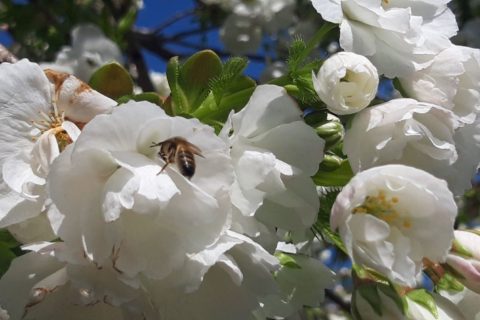
Detail of a cherry tree in bloom
#BlossomWatch, a new way to celebrate Spring
#BlossomWatch is a new way to engage people with nature. The initiative is part of the Trust’s “Everyone Needs Nature” campaign to help people of all ages to become more connected with everyday nature. The trust takes care of hundreds of blooming trees, many of which are historical varieties. This includes the tree said to inspire Newton’s theory of gravity and the orchard that Thomas Hardy loved to play in as a child.
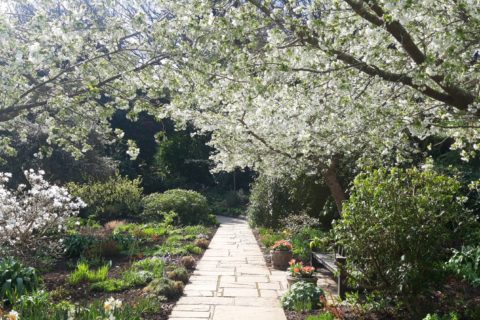
Cherry Blossom
The Trust said that blossom sweeping the country is one of nature’s key moments. It could help lift the spirits during these uncertain times and enable people to celebrate nature and history together. The Trust hopes to encourage people to engage with annual moments in nature’s calendar, something the majority of British people don’t currently do. Only 6% of adults and 7% of children celebrate natural events such as the first day of spring, solstice or harvest, according to the Trust’s recent research.
People who can see the blossoms are asked to share their pictures on social media via @nationaltrust on Instagram and Twitter, using #BlossomWatch and tagging their location. It allows everyone to enjoy this year’s blossom season. So, take a moment on your daily walk or run to enjoy the fleeting beauty of blossom and celebrate Hanami. Whenever you are, connect with nature to lift your spirits, even if it’s just for a moment or so.
Identifying trees in bloom
Apple trees
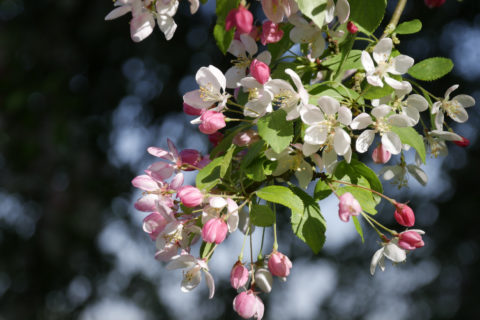
Crab apple blossom in the garden at Wimpole, Cambridgeshire.
Apple trees bloom in March-April. They are short trees that grow in hedges and bushes on moist soil. They are recognizable by their white flowers with a touch of pink and their greyish-brown spotted bark and knotty shape. Local varieties of apple are chosen for the orchard to help preserve trees which have been cultivated in the Tamar Vallery for centuries.
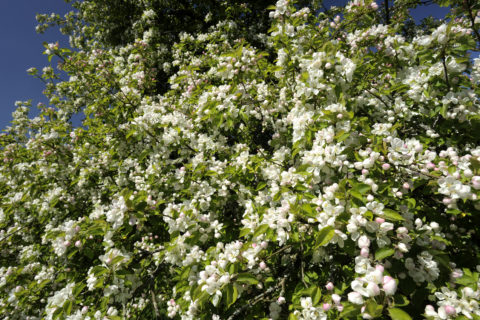
Apple tree in blossom in April, in the fruit orchard at Cotehele, Cornwall.
Cherry Trees
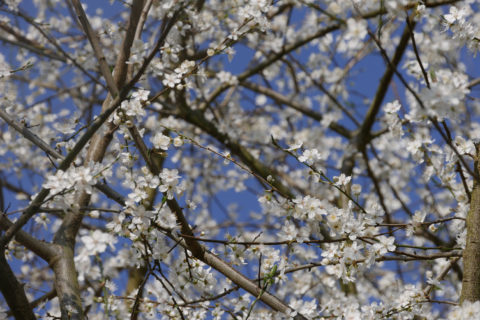
Cherry blossom in the garden of Dunster Castle, Somerset
Wild cherry trees are recognizable by their small white flowers that appear in April-May. They love sunlight and grow on fertile land, usually singly in hedgerows or on the edge of woods. Their bark is reddish-brown, marked with horizontal “scars”. Other varieties have small pink flowers.
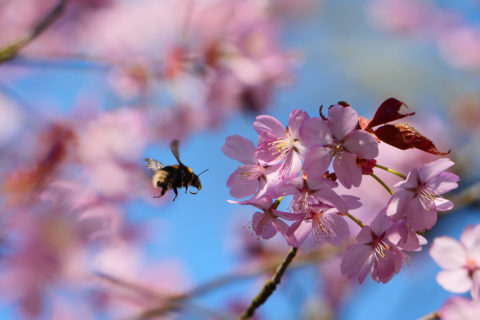
Cherry blossom at Sheringham Park
Damson Blossom
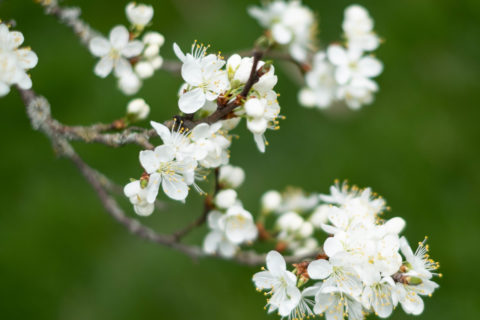
Damson blossom at Brockhampton
Damson trees blossom with little white flowers in clusters. Flowers appear in early April. They form an umbrella-shaped cluster on short spurs. Damson trees need moist soil to grow. They are resistant to cold and strong winds.
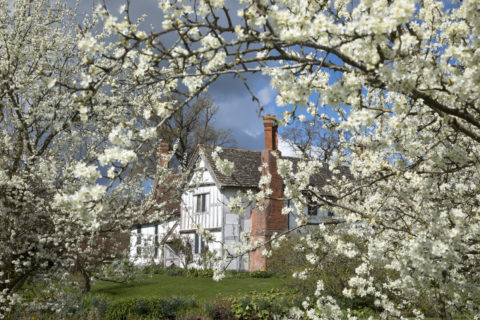
Damson blossom in bloom at Brockhampton
Hawthorn trees
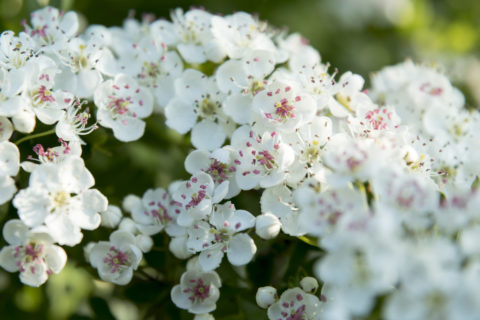
Hawthorn in flower at Stockbridge Down, Hampshire
Hawthorn trees are known as May-flower. They have pinkish-white flowers that attract songbirds. Hawthorn trees are often located in hedgerows, woodland edges and scrubland. Their wood is hard and very fine-grained. It is used to make cabinets, boxes and tool handles, as good firewood and charcoal.

Hawthorn in flower at Stockbridge Down, Hampshire
Pear Trees
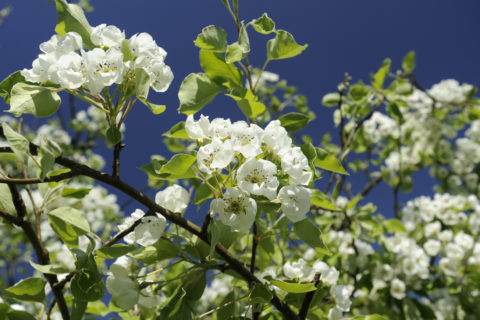
Pear blossom in April in the fruit orchard at Cotehele, Cornwall.
Pear trees are recognizable by their white flowers and glossy leaves that appear in abundance in early spring. Blooming pear trees provide an abundance of shade with their thick and umbrella shaped canopy. Pear trees are fire-resistant trees that enjoy the sun.
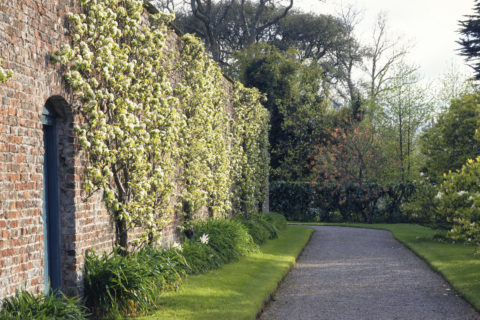
Fan trained Pears on the old kitchen garden wall in the grounds of Antony House
Plum Trees

Comma butterfly on prunus pissardii (purple leaved plum blossom) in the formal garden at Tyntesfield, Somerset
Plum trees offer beautiful round white flowers in abundance. The colour of the flowers can vary, sometimes taking on purple hues. Plum trees bloom from January to March. They are hardy trees that thrive in different types of soil. In a good year, about half of the flowers are pollinated and become plums.
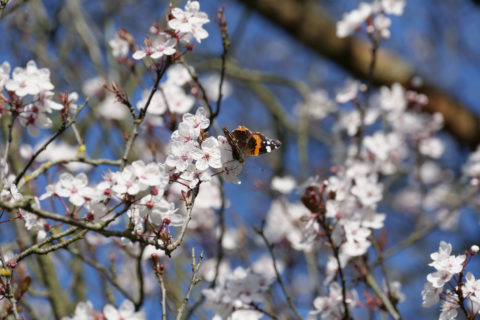
Red admiral butterfly on prunus pissardii (purple leaved plum blossom) in the formal garden at Tyntesfield, Somerset



